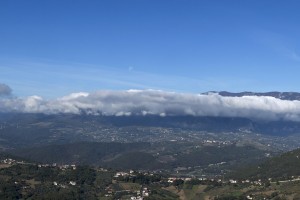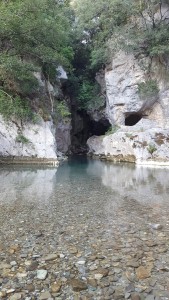
©Bigstock.com/Pfmphotostock
You’ve certainly heard us say this many times before, but it absolutely bears repeating in this case: Italy’s magnificent nature with its highly diverse wildlife is most certainly worth protecting. Numerous national parks throughout the country assume this task. Cilento and Vallo di Diano National Park was only established in 1991 and declared UNESCO World Heritage Site a mere seven years later – a rapid, almost unprecedented rise. But what is it that makes this park so unique? Unrivalled scenery aside, several invaluable archaeological and historical sites are hidden throughout the sweeping territory. It is now time to discover those very sites as well as Cilento and Vallo di Diano National Park together.
The National Park
First things first, let’s immerse ourselves in the stunning world of the park itself. Italy’s second-largest national park is located in the province of Salerno in Campania. Covering an impressive 181,048 hectares, it stretches from the coast of the Tyrrhenian Sea to the Vallo di Diano valley on the foot of the Apennines. Let the diversity of this region enchant you with highlights such as Monte Cervati, the highest mountain of the park at 1,898 m, the amazing gorge of Calore, the river valleys covered with forests and olive groves, or the breathtaking blend of imposing steep coasts and wide sandy beaches. The coastal region in peak season aside, you get to experience virtually empty beaches and completely sleepy villages in spring and autumn. Hikers and cyclists cherish the diverse selection of marked routes. But there’s also quite a lot in store for divers and snorkelers, paragliders, white water adventurers, cave explorers and horseback riding enthusiasts.

©Bigstock.com/nessuno041001
It’s easy to overlook what Cilento and Vallo di Diano is actually all about with all of those adventures and explorations, but its highly diverse wildlife possesses an undeniable allure. According to park administration estimates, about 1,800 different species of wild plant can be found throughout the entire area, about 10% of which are endangered. The more mountainous zones don’t just offer ideal fertile soil for beeches, holly oaks, alders and chestnuts, it also provides the perfect habitat for golden eagles, alpine rock partridges and the Corsica rabbit. Even wolves and alpine ibexes have made the ranges their home. The streams of Calore Valley are home to fire salamanders, spectacled salamanders and the endangered otter. Water buffalos, whose milk is the foundation for the popular buffalo mozzarella, can be found in this region, too. And don’t even get us started on the many other quaint, inviting places, such as the friendly coastal village Marina di Camerota or Palinuro with its particularly clear water and mysterious caves…
Archaeological site in Paestum
After this crash course in national park culture we move on to a decisively more historical field consisting of a whopping three places that were also declared UNESCO World Heritage Site. Our first stop leads us to Paestum in Capaccio. Greeks founded Poseidonia, the colony of a colony (a so-called “apoikia”), here around 600 BC. The upcountry location suggests that the main criterium for settling there was the particularly fertile soil. The city achieved impressive wealth over the course of just a few generations. Large temples were built. When taking over Campania from 274 to 273 BC, the Romans called the area Paestum, reshaped it recklessly and let it drift into oblivion. Completely abandoned after the fall of the Roman Empire, the rediscovery around 1752 – almost at the same time as Pompeii and Herculaneum, by the way – caused quite a stir. Paestum became an integral part of the education-based Grand Tour of young upper-class men.
Today you get to see numerous ruins and ancient monuments dating back to Greek and Roman times. Your main focus should be on the three large Doric temples. Each one of them – the archaic Hera temple, the rather unusually vested Athena temple and the technically mature Poseidon temple – represents a different architectural era. The small Roman amphitheatre, the comitium (a civic assembly place) and the long city walls will catch your eye as well. The museum features a collection of important Greek antiquities from Lower Italy with ostentatious tomb displays and slabs.
Archaeological site in Velia
Also known as Elea in Greek times, Velia was an important port town in ancient Greece and the home of the Eleatic school of philosophers, one of the oldest of its kind. Parmenides’ concept of being and non-being had great influence on Plato. Founded by Greeks that had fled from the Persian invasion, Velia quickly became an influential trading town and served as an ally of Rome first and a valuable military base later during both Punic Wars. Relocated trade routes and harbour siltation impoverished Velia leading to its eventual abandonment around the 9th century AD.
Only the harbour area somewhat survived the times. Porta Rosa is of special significance. The gate was used as both a connection between two districts and as a viaduct supplying the high-lying acropolis with water. You can still view the acropolis, too, as well as various Hellenic and Roman temples.
Padula Charterhouse
Finally, we take a look at Italy’s largest and likely best-known charterhouse with a total area of 250,000 m² (including the park), 30,000 m² of which are overbuilt. Founded by Tommaso Sanseverino, Count of Marsico, on 28 January 1306, it would take close to 70 years until the completion of the minster. Several alternations and expansions were to follow. Baroque elements now shape both the garden and the monastery. 84 pillars frame the largest cloister in the world (12,000 m²). Padula Charterhouse was abandoned in 1866 with restoration works commencing about 100 years later. Nowadays, this monumental building managed to retain its former baroque shine housing the Archaeological Museum of Western Lucania with exciting finds from the necropolis of Sala Consilina and Padula.
The astonishing variety and spectrum of this UNESCO World Heritage Site continues to impress time and time again. You can spend several weeks in the national park area with its diverse sports and leisure options, sleepy villages and invaluable historical sights without even getting remotely enough, let alone having experienced everything. We cannot recommend a trip to Cilento and Vallo di Diano National Park highly enough, particularly beyond the peak summer season.